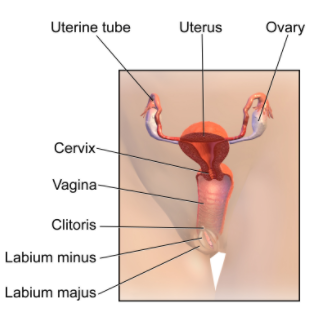
Which of the following is not a part of the female reproductive system in human beings?
(A) Ovary
(B) Uterus
(C) Vas deferens
(D) Fallopian tube
Answer
513.7k+ views
Hint:Human beings reproduce sexually, where production of gametes takes place in the reproductive system. The female reproductive system consists of parts, which help in production of ovum, release of ovum (ovulation), fertilisation, supporting implantation of embryo and providing space for the development of the foetus.
Complete answer:
The female reproductive system of human beings consists of a pair of ovaries, a pair of oviducts, uterus, cervix, vagina and the external genitalia. It is present in the pelvic region. The female reproductive system is designed structurally and functionally in such a way that it helps in ovulation, fertilisation, pregnancy and childbirth.

Ovaries are the primary sex organs which is involved in the production of eggs, along with hormones like oestrogen. The oviducts (otherwise known as fallopian tubes), uterus and vagina are female accessory ducts. Fallopian tube is the one which receives the egg from the respective ovary and is the site of fertilisation. Fallopian tubes lead to the uterus, which supports the growth of the foetus. The distal portion of the uterus opens into the vagina through a narrow cervix. The external genitalia consists of mons pubis, labia majora, labia minora, hymen and clitoris.
Understanding the options one by one,
>Option (A), (B) and (D) - Ovary, uterus and fallopian tube are parts of the female reproductive system in human beings.
>While, Option (C) – vas deferens is not a part of the female reproductive system. This is the correct answer.
Therefore, the correct answer is option (C)
Note:Understanding the structure, parts of the reproductive system and function associated with it, is essential to answer these types of questions. Vas deferens is a male sex accessory duct of male reproductive system in human beings. It is a long, muscular tube that originates from epididymis and opens into the pelvic cavity. It helps in the transportation of sperms from testis to the ejaculatory duct.
Complete answer:
The female reproductive system of human beings consists of a pair of ovaries, a pair of oviducts, uterus, cervix, vagina and the external genitalia. It is present in the pelvic region. The female reproductive system is designed structurally and functionally in such a way that it helps in ovulation, fertilisation, pregnancy and childbirth.

Ovaries are the primary sex organs which is involved in the production of eggs, along with hormones like oestrogen. The oviducts (otherwise known as fallopian tubes), uterus and vagina are female accessory ducts. Fallopian tube is the one which receives the egg from the respective ovary and is the site of fertilisation. Fallopian tubes lead to the uterus, which supports the growth of the foetus. The distal portion of the uterus opens into the vagina through a narrow cervix. The external genitalia consists of mons pubis, labia majora, labia minora, hymen and clitoris.
Understanding the options one by one,
>Option (A), (B) and (D) - Ovary, uterus and fallopian tube are parts of the female reproductive system in human beings.
>While, Option (C) – vas deferens is not a part of the female reproductive system. This is the correct answer.
Therefore, the correct answer is option (C)
Note:Understanding the structure, parts of the reproductive system and function associated with it, is essential to answer these types of questions. Vas deferens is a male sex accessory duct of male reproductive system in human beings. It is a long, muscular tube that originates from epididymis and opens into the pelvic cavity. It helps in the transportation of sperms from testis to the ejaculatory duct.
Recently Updated Pages
Master Class 12 English: Engaging Questions & Answers for Success

Master Class 12 Business Studies: Engaging Questions & Answers for Success

Master Class 12 Economics: Engaging Questions & Answers for Success

Master Class 12 Social Science: Engaging Questions & Answers for Success

Master Class 12 Maths: Engaging Questions & Answers for Success

Master Class 12 Chemistry: Engaging Questions & Answers for Success

Trending doubts
What are the major means of transport Explain each class 12 social science CBSE

Which are the Top 10 Largest Countries of the World?

Draw a labelled sketch of the human eye class 12 physics CBSE

Explain sex determination in humans with line diag class 12 biology CBSE

The pH of the pancreatic juice is A 64 B 86 C 120 D class 12 biology CBSE

Explain sex determination in humans with the help of class 12 biology CBSE




